Original Title: "Silent Buyers: How ETFs and On-Chain Whales Rewrite the Supply and Demand Rules of BTC? | WTR 6.16"
Original Source: WTR Research Institute
Weekly Review
From June 9 to June 16 this week, the highest price of Bitcoin (BTC) was around $110,530, and the lowest was close to $102,664, with a fluctuation range of about 7.12%. Observing the chip distribution chart, there is a significant amount of chips traded around $103,876, which will provide certain support or pressure.
• Analysis:
- 60000-68000 approximately 1.2 million coins;
- 76000-89000 approximately 1.24 million coins;
- 90000-100000 approximately 1.4 million coins;
• The probability of not breaking below $95,000 to $100,000 in the short term is 80%;
Important News
Economic News
Market Opening Performance:
• On Monday, U.S. stock indices opened, with the Nasdaq index rising 1.6% during the session, and the S&P 500 index rising 1.06%.
• Gold fell by 1%, Brent crude oil fell by 2%, and the U.S. dollar index fell by 0.17%.
Federal Reserve (FOMC) Dynamics and Rate Cut Expectations:
• This Thursday at 02:00, the Federal Reserve FOMC will announce its interest rate decision and economic outlook summary.
• Due to the recently released CPI (Consumer Price Index) and PPI (Producer Price Index) data being weaker than expected, the market has brought forward its expectations for the next rate cut, believing that there is a high probability of a rate cut in September.
• The market is focused on whether the Federal Reserve will provide clear signals regarding the timing of future rate cuts.
• Citigroup analysts pointed out that the current market may be underestimating the possibility of a rate cut.
• Jefferies economist Mohit Kumar stated that Federal Reserve Chairman Powell may emphasize the uncertainty in economic growth and inflation outlook, suggesting a tone of not rushing to cut rates but being prepared to respond when the economy needs it.
• The market generally expects Federal Reserve Chairman Powell to maintain a neutral stance.
Geopolitical and Market Impact:
• Ahead of the Federal Reserve's interest rate meeting, one of the market's focal points is the conflict between Israel and Iran.
• The ongoing tensions in the Middle East and concerns over geopolitical conflicts are putting pressure on risk assets.
Institutional Predictions:
• Goldman Sachs maintains its forecast, believing that gold prices will reach $3,700 per ounce by the end of 2025 and $4,000 per ounce by mid-2026.
Cryptocurrency Market News
Hong Kong Stablecoin Regulatory Progress:
• Hong Kong Financial Secretary Paul Chan stated that as the digital asset market develops, the demand for stablecoins will increase.
• The "Stablecoin Ordinance" has been passed by the Legislative Council and will take effect on August 1.
• After the ordinance takes effect, the Hong Kong Monetary Authority will process the received license applications as soon as possible, aiming to attract global institutions to issue stablecoins in Hong Kong based on actual application scenarios to enhance market liquidity and competitiveness.
• Last year, the total trading volume of digital assets and related products by local banks in Hong Kong reached HKD 17.2 billion, with the total amount of digital assets held in custody by banks reaching HKD 5.1 billion by the end of the year.
Cryptocurrency Market Performance and Analysis:
• Circle (USDC issuer) rose 20% during the session, with a market capitalization of $35 billion.
• BTC rose 2.2%, and ETH rose 3.6%.
• QCP Analysis: Despite the tense situation in the Middle East, BTC did not experience panic selling, indicating an improvement in market resilience, with continued accumulation by institutions becoming a key support.
• 10x Research Analysis: Against the backdrop of rising oil prices, firm U.S. Treasury yields, data divergence, and the Federal Reserve's caution, BTC's macro fundamentals are quietly strengthening. The longer the consolidation period, the greater the likelihood of a future breakout.
• Seasonal factors in summer may lead BTC to continue consolidating in the short term, but the macro signals turning towards the medium to long term lay the foundation for potential increases within the year.
• BTC Cycle Performance: The performance of this cycle is similar to the past, with a rise of 1,076% from 2015-2018, 1,007% from 2018-2022, and a rise of 656% from 2022 to present.
ETF Fund Flows:
• Last week, the total inflow of U.S. BTC spot ETFs was $1.37 billion, with BlackRock's IBIT inflow being $1.1159 billion.
• Last week, the inflow of U.S. ETH spot ETFs was $528.2 million.
• The spot BTC ETF has recorded net inflows for the seventh consecutive week.
• CoinShares data: Digital assets have achieved net inflows for the ninth consecutive week, with last week's inflow being $1.9 billion, and the total inflow during this round reaching $12.9 billion, with the total inflow since the beginning of the year reaching a new high of $13.2 billion.
• Bloomberg ETF analyst Eric Balchunas stated that BlackRock's BTC spot ETF has surpassed $70 billion in holdings, becoming the fastest ETF to reach this milestone in just 341 days.
Corporate Holdings and On-Chain Data:
• U.S. publicly listed company SharpLink Gaming invested $463 million to increase its holdings of 176,271 ETH, becoming the company with the largest ETH holdings.
• Japanese listed company Metaplanet increased its holdings by 1,112 BTC, bringing its total holdings to 10,000 BTC.
• Santiment data: Currently, there are 6,392 addresses holding 1,000 to 100,000 ETH, and these addresses have collectively increased their holdings by 1.49 million ETH over the past 30 days, an increase of 3.72%.
Market Predictions and Future Catalysts:
• Cointelegraph reports: Market consensus is not bearish; the bull market is not over, and the market believes BTC is preparing to enter a new round of price discovery, with expectations for the price to reach $170,000, while $113,000 is seen as the only obstacle.
• VanEck digital asset head Matthew Sigel stated that low market cap listed companies claiming to establish large-scale crypto reserves could be seen as a scam, likely just to inflate the company's stock price.
• Potential catalysts: The possible rate cut by the Federal Reserve at the end of summer and the U.S. "GENIUS Stablecoin Act" may become opportunities to stimulate a market reversal.
U.S. Regulatory Dynamics:
• The U.S. Securities and Exchange Commission (SEC) announced four senior personnel appointments, including two members with digital asset experience, which is interpreted as a signal of a more friendly stance towards the crypto industry from SEC head Paul Atkins.
Stablecoin Market Data:
• The total market capitalization of stablecoins increased by 0.63% over the past 7 days, reaching $251.542 billion.
Long-term Insights: Used to observe our long-term situation; bull market/bear market/structural change/neutral state
Mid-term Exploration: Used to analyze what stage we are currently in, how long this stage will last, and what situations we will face
Short-term Observation: Used to analyze short-term market conditions; and the possibility of certain events occurring in a certain direction under certain premises
Long-term Insights
• Non-liquid long-term whales
• Total spot selling pressure
• ETF reserve status
• Long-term investors holding for more than six months
• Large net transfers on trading platforms
• Short-term speculators' cost line
Part One: Core On-Chain Data Analysis
(The following image shows non-liquid long-term whales)

The most far-sighted and financially powerful participants in these markets are in a continuous and steep accumulation cycle. This is not short-term behavior, but a long-term, strategic asset allocation. It indicates that the most influential capital is systematically increasing its core holdings during the current phase.
(The following image shows total spot selling pressure)

The overall willingness to sell in the current market is at a recent low. This means that regardless of how prices fluctuate, the holder group—whether in profit or loss—has shown a considerable "reluctance to sell" mentality. The urgency to sell is weak, providing a solid underlying environment for the market.
(The following image shows ETF reserve status)

The fund flow of ETFs has transitioned from an early "explosive" influx to a more mature and stable "allocation" net inflow phase. Although the daily inflow amount has decreased, the key point is that the fund flow has not reversed and continues to maintain overall net inflow or balance. This represents a continuous background buying power from the mainstream financial world.
(The following image shows long-term investors holding for more than six months)

This is the most macro and structural indicator. Over 53.5% of the supply has been locked by long-term holders, and this number is still rising rapidly. This fundamentally changes the market's supply structure, with a large number of tokens exiting the short-term circulation market and entering a "quasi-inventory" state, continuously reducing the effective supply available for trading.
(The following image shows large net transfers on trading platforms)
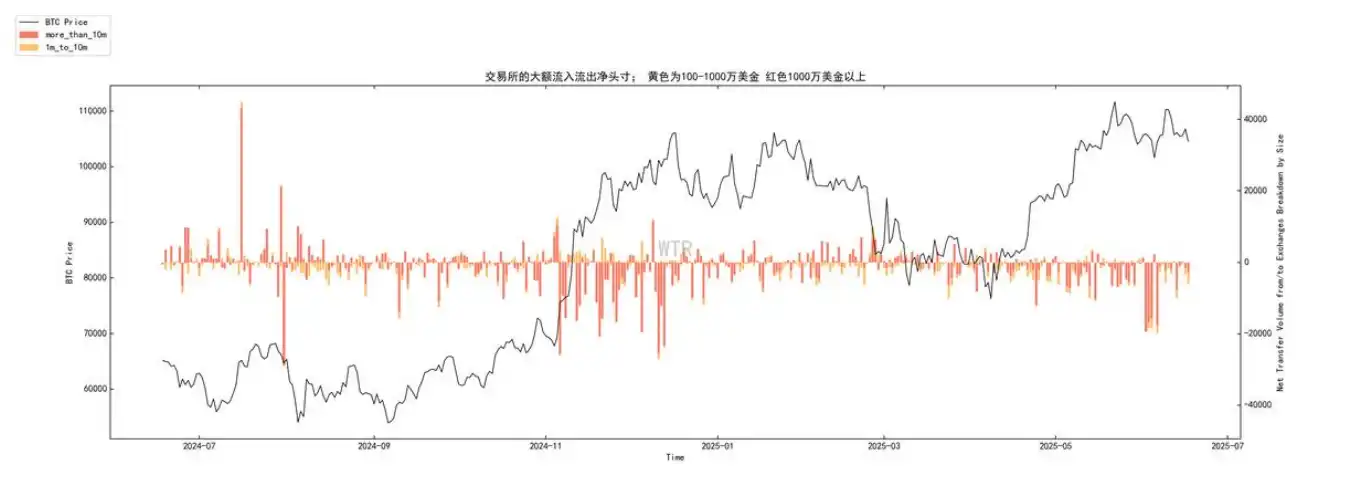
Recent data shows that large transfers are primarily net outflows. This is a clear signal indicating that large investors, after purchasing, tend to withdraw assets from trading platforms and move them into private wallets. The motivation for this behavior is long-term storage rather than short-term trading, which directly leads to a decrease in the available spot inventory on trading platforms.
(The following image shows short-term speculators' cost line)
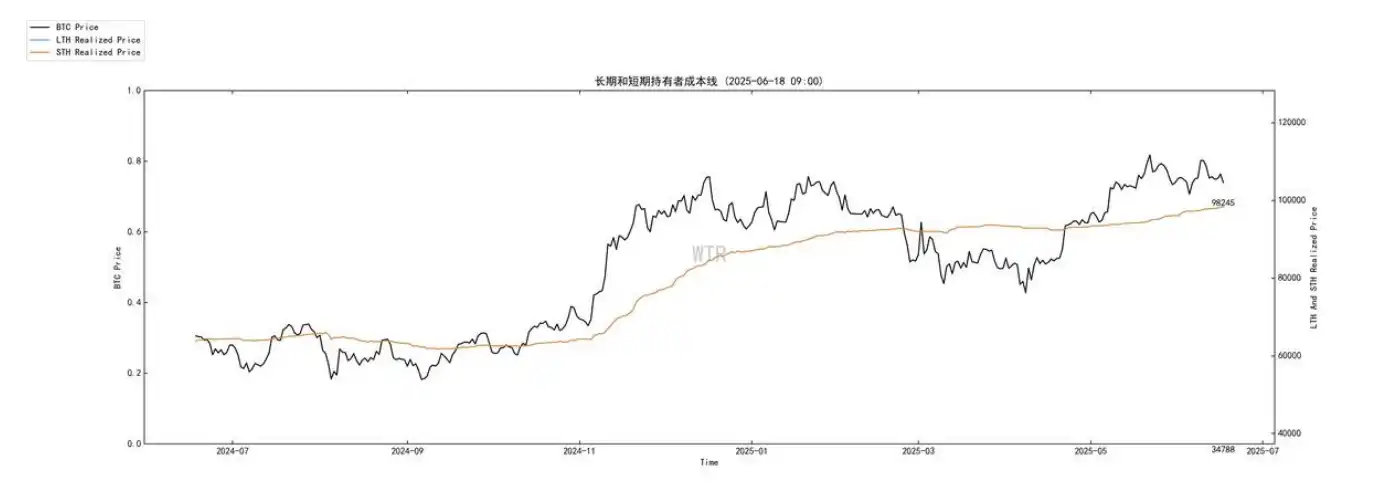
- The cost line at $98,245 is the psychological profit and loss dividing line for recently active funds in the market. It serves as the "Marichino defense line" for short-term market sentiment; if the price operates above it, the market is relatively safe; if it falls below, it may trigger stop-loss behavior among short-term traders.
Part Two: In-Depth Integrated Analysis
The surface of the market is a confrontation between macro uncertainty and strong micro data. Traders are closely watching the Federal Reserve's movements, as if the fate of the market hangs by a thread. The narrow price fluctuations intensify this "calm before the storm" atmosphere. However, stepping back reveals a profound paradox: if the macro chill is so pressing, why do the various "vital signs" within the market appear so healthy and robust? Long-term holders are increasing, whales are accumulating, and selling pressure is decreasing.
This indicates that the internal structure of the market is undergoing some profound changes, making it more resilient to external "weather." The real story may not be about the weather, but about the body itself. To understand this internal change, we can use the metaphor of "tectonic plates," integrating all data into this framework. The "geological composition" of the cryptocurrency asset market is undergoing fundamental changes. The core driving force of this "geological movement" comes from the continuous increase of "long-term investors," who are the chief engineers. More than half of the territory has transformed from soft, erodible "quicksand" into solid "bedrock." The details of this engineering can be clearly seen:
• "Non-liquid long-term whales" and "ETFs" are the two main construction teams. The former acts like the tectonic forces within the plates, compressing and solidifying the ground from within; the latter resembles external land reclamation projects, continuously bringing new, stable materials to this landmass.
• "Large net outflows from trading platforms" serve as the construction diary, recording the process of "bedrock" materials (tokens) being dredged from the flowing "ocean of the market" and firmly fixed onto the continental plate.
• The result of this geological movement is a significant enhancement of the continent's stability. The reduction in "total spot selling pressure" is like a weather station report, indicating that even with a storm (macro headwinds), it is difficult to stir up clouds of dust as in the past, because most of the sand has turned into rock.
On this increasingly solid bedrock continent, there lies a thin layer of flowing surface soil. The "average altitude" of this surface soil is the cost line of "short-term speculators": $98,245. The macro "tide"—that is, the Federal Reserve's monetary policy—primarily acts on this layer of surface soil, washing out daily price fluctuations. Thus, the overall picture becomes clear. The surface tension of the market is a normal phenomenon produced when the macro tide washes over an increasingly solid and expanding continent. People feel nervous because they overly focus on the fluctuations of the tide, neglecting the deeper, more enduring uplift of the continent beneath their feet. This is not a fragile tug-of-war, but an interaction between periodic natural phenomena (macro cycles) and structural geological evolution (ownership transfer).
As a result, the market's response pattern has changed: it has developed a stronger resistance to negative tides (macro headwinds) because most of the land is now bedrock; while for positive tides (macro tailwinds), it may produce higher and more rapid waves due to the narrowing of channels (liquidity).
Part Three: Outlook
Short-term Outlook:
In the short term, the focus remains on the "tide." The Federal Reserve's decisions are the biggest variable, directly determining the height of the tide and thus triggering price fluctuations. The "coastline" at $98,245 will be a key observation point, and the market will repeatedly test this level. Any macro headwind could temporarily push prices below this line, but this should be seen as an opportunity to observe the strength of the "bedrock" support.
Medium to Long-term Outlook:
The core of the medium to long-term outlook is the "geological movement" itself. We need to continuously measure the rate of bedrock thickening—namely, the proportion of long-term investors, the sustainability of ETF inflows, and the dynamics of whale accumulation. As long as this movement continues, the territory of the continent is expanding, and the market's value foundation is deepening. When the next macro tailwind "high tide" arrives, what it will lift will be a value entity far larger and more solid than in the past.
Mid-term Exploration
• Liquidity supply
• Whale purchasing power composite score
• BTC trading platform trend net position
• Incremental model
• Global purchasing power
• On-chain total chip distribution structure
(The following image shows liquidity supply)

The new liquidity supply in the current market has declined, suggesting that the market still leans towards a structure of stock oscillation games. If this state continues, the market may continue to slide under the current structure, and the overall direction will still require time to wait. From another perspective, market participants may also be observing and deliberating in their games.
(The following image shows whale composite score)
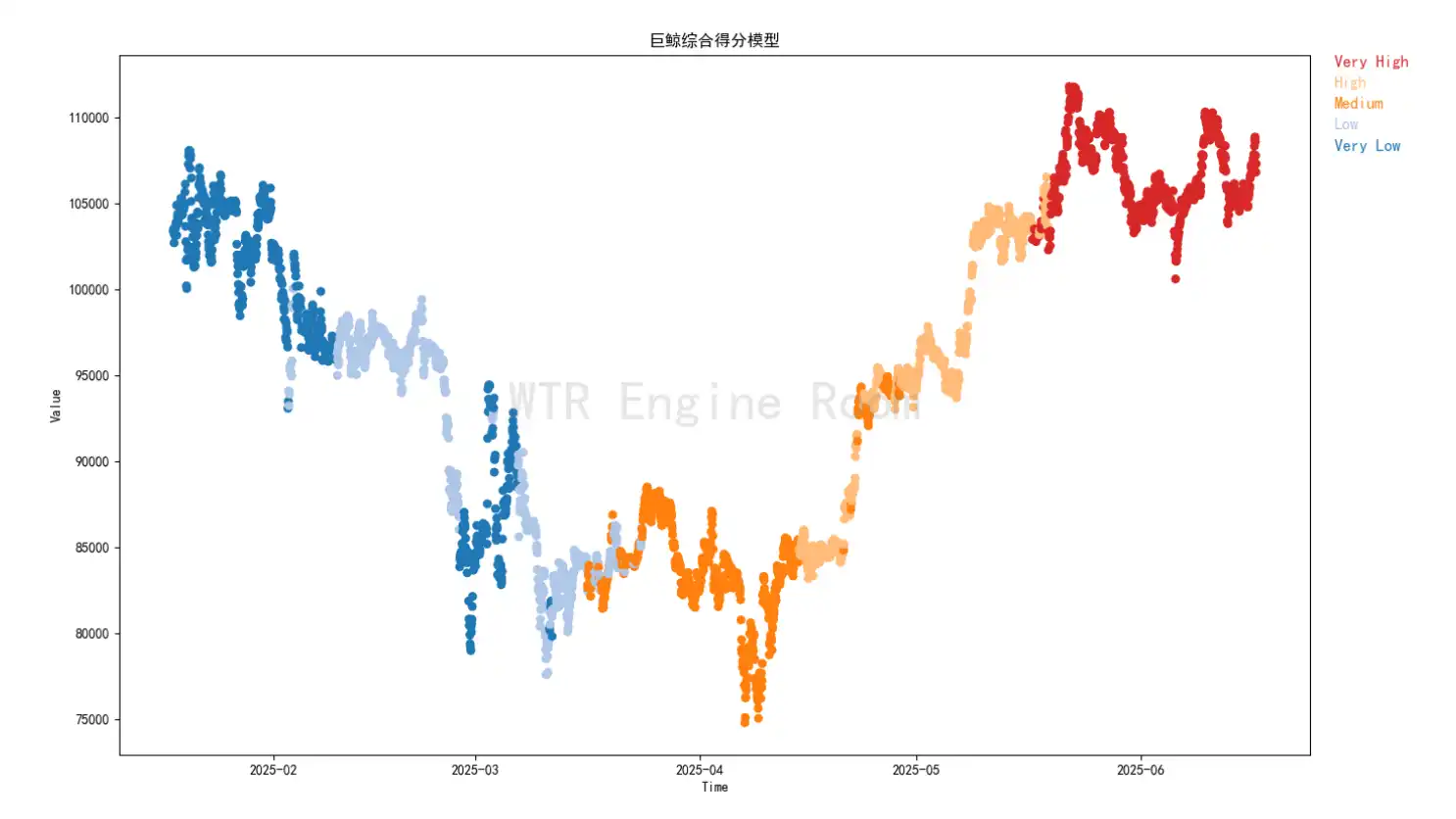
Whales still retain a strong liquidity supply, and large participants in the market are actively engaged in the game. Due to the decline in new liquidity supply, the current whales in the market tend to be in a stock state. Stock whales are also the main body maintaining BTC's high oscillation state.
(The following image shows BTC trading platform trend net position)
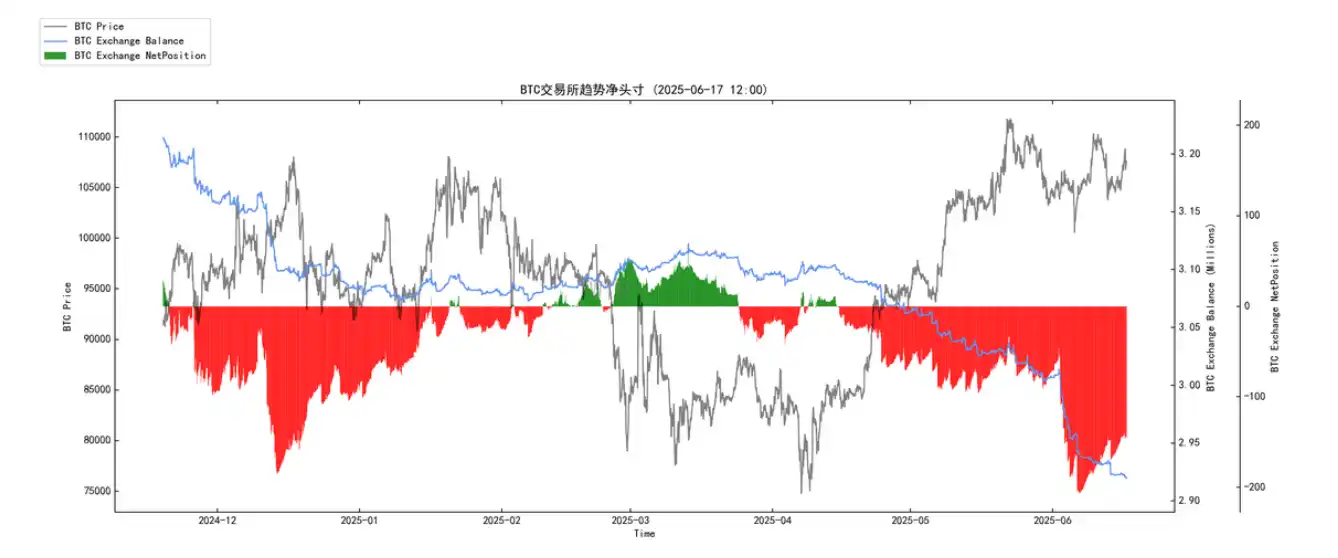
BTC is still accumulating on trading platforms. In the current phase, it maintains a weak accumulation state, with BTC flowing out of trading platforms in small amounts.
(The following image shows incremental model)

The supply of short-term participants is continuously declining, and the market has been in a stock state of increase since the rise began in April 2025. The previous weekly report mentioned that due to the continuous buying power in the market and the increase in short-squeeze volume, the market has reached a high position. If the incremental state continues as it is now, the possibility of a significant market explosion in the near term will continue to decrease. The market still needs time to game, and everyone may be waiting for a turning point.
(The following image shows global purchasing power)
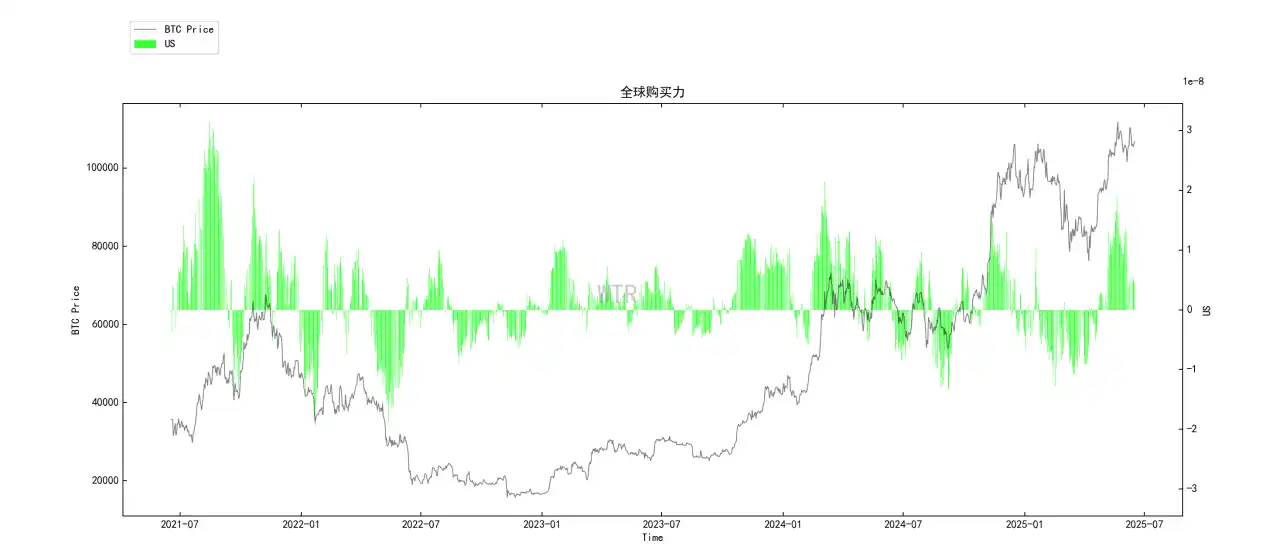
Global purchasing power is currently declining, which may indicate that as purchasing power gradually contracts, the market is slowly returning to rationality and calm.
(The following image shows on-chain total chip distribution structure)
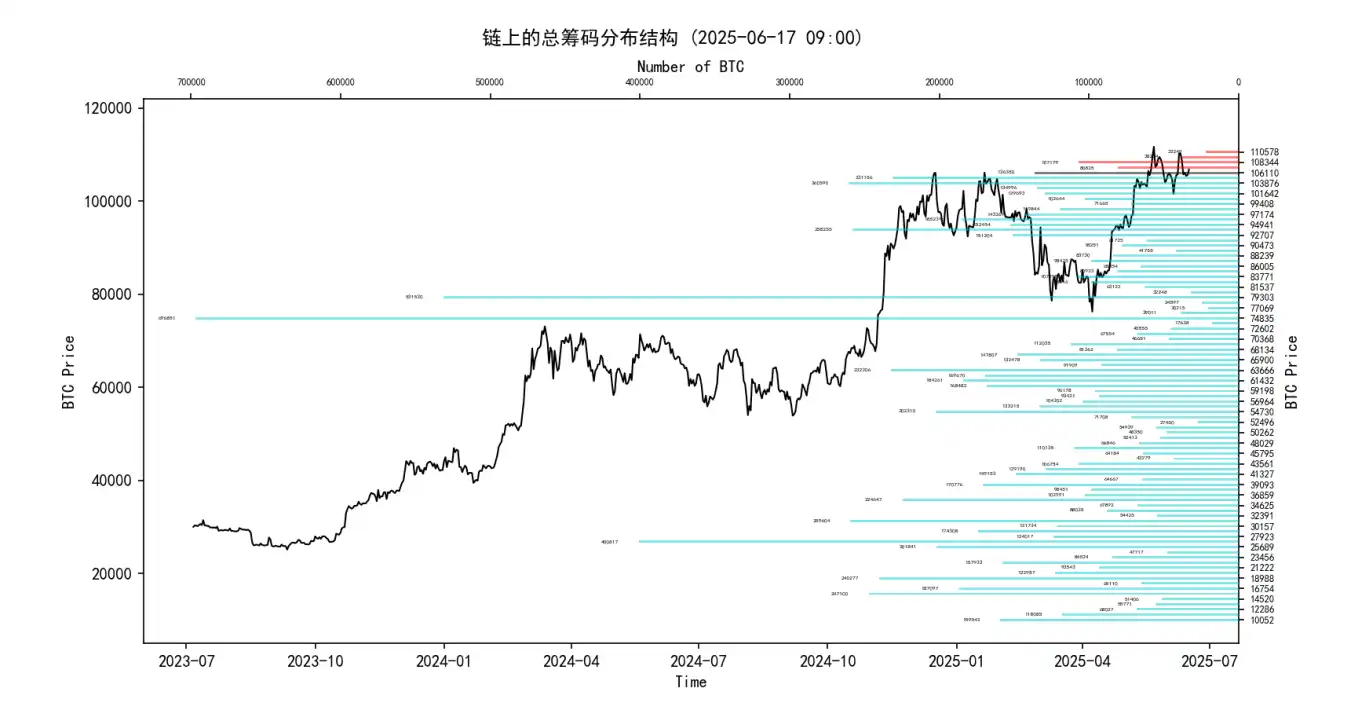
From the perspective of chip transaction structure, the current oscillation structure support level is around $102,000. At the same time, due to the low transaction volume around $110,500, if incremental supply does not continue, the energy for price increases will weaken as it crosses the $110,500 level.
Short-term Observation
• Derivative risk coefficient
• Options intent transaction ratio
• Derivative transaction volume
• Options implied volatility
• Profit and loss transfer volume
• New addresses and active addresses
• Pionex trading platform net position
• Yita trading platform net position
• High-weight selling pressure
• Global purchasing power status
• Stablecoin trading platform net position
Derivative Rating: The risk coefficient is in the red zone, indicating high derivative risk.
(The following image shows derivative risk coefficient)
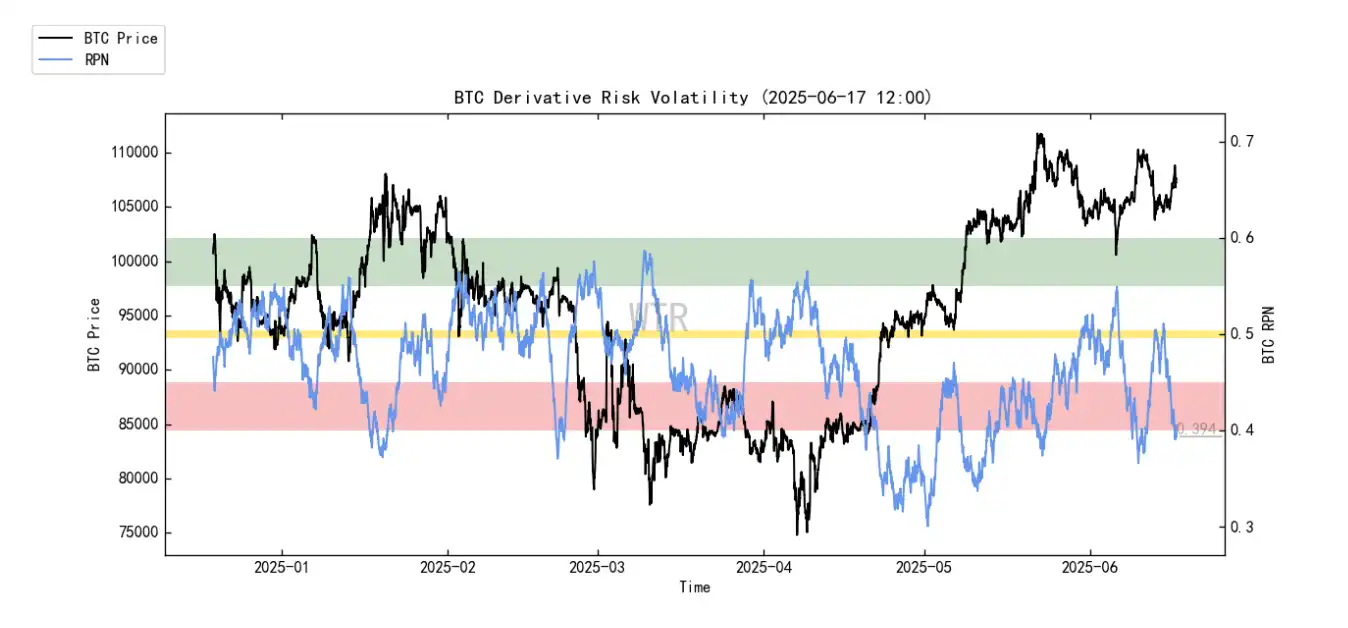
The derivative risk coefficient has once again entered the red zone, indicating that this week, the market maintains a higher probability of oscillation based solely on derivatives, and even short squeezes will be much smaller in magnitude.
(The following image shows options intent transaction ratio)

The ratio and volume of put options have increased, currently at a high level.
(The following image shows derivative transaction volume)

Derivative transaction volume is at a low level.
(The following image shows options implied volatility)
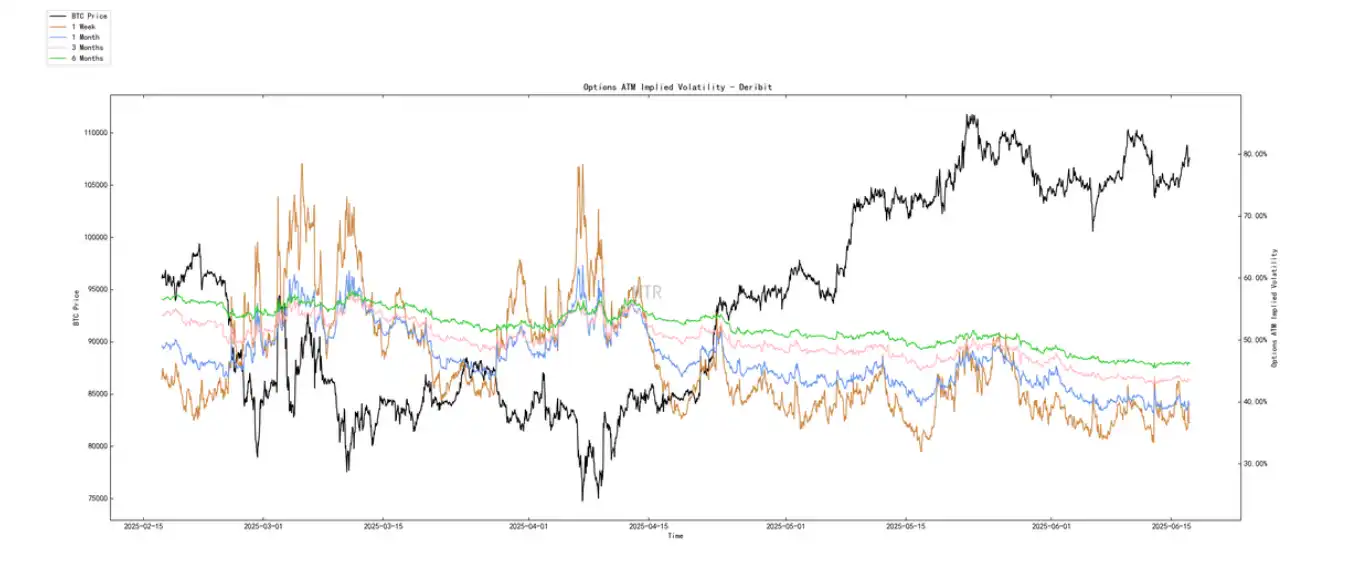
Options implied volatility has only shown low amplitude fluctuations in the short term.
Sentiment state rating: Neutral
(The following image shows profit and loss transfer volume)

Consistent with last week, the overall market sentiment remains relatively neutral and cautious.
(The following image shows new addresses and active addresses)

New active addresses are at a medium-low level.
Spot and selling pressure structure rating: BTC is in a continuous large outflow state, while ETH has a small outflow.
(The following image shows Pionex trading platform net position)
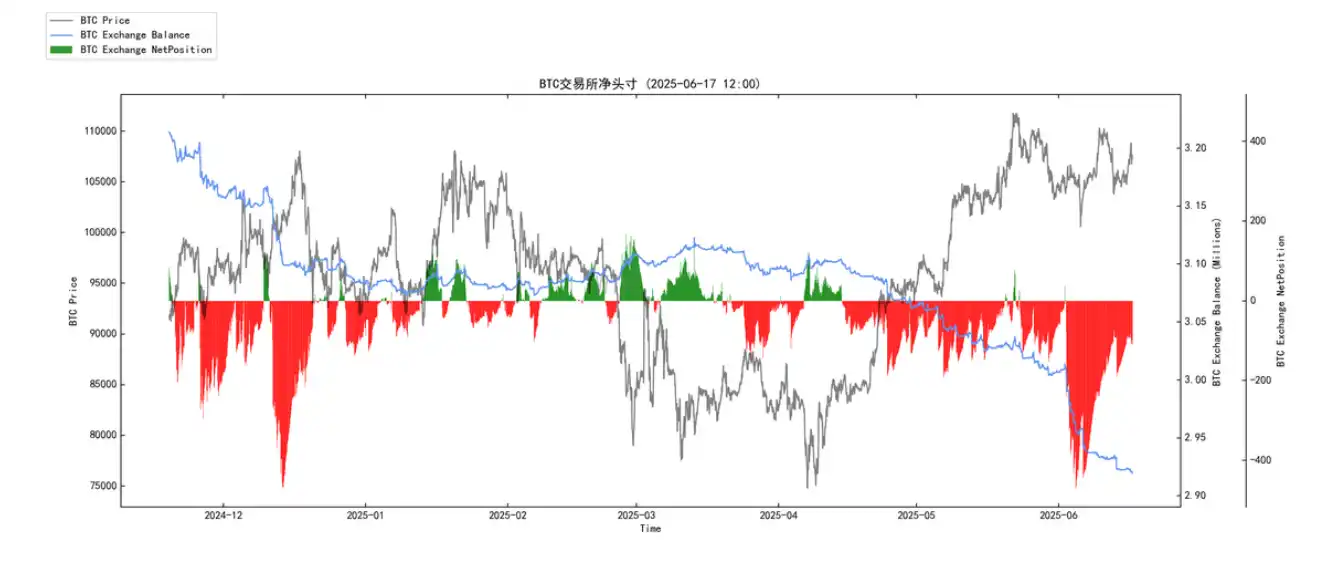
Currently, BTC is experiencing continuous large outflows.
(The following image shows Yita trading platform net position)
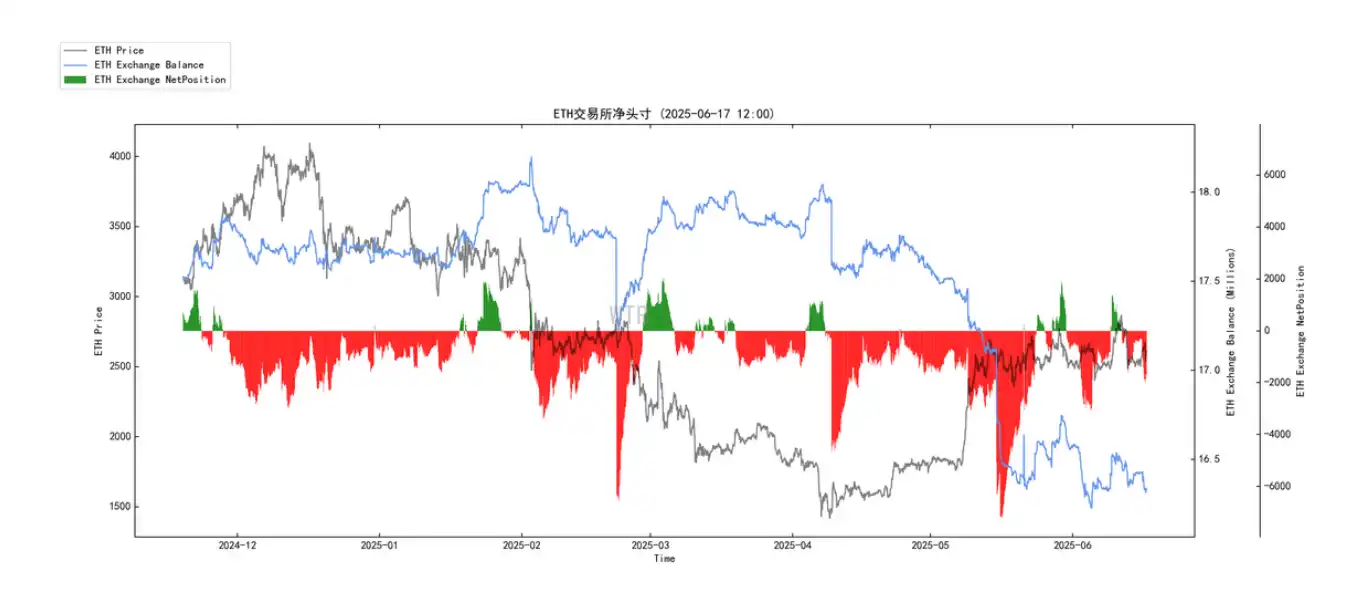
With the rebound in ETH prices, there has been a small inflow into the ETH trading platform net position. This has now been digested and has turned into a small outflow.
(The following image shows high-weight selling pressure)
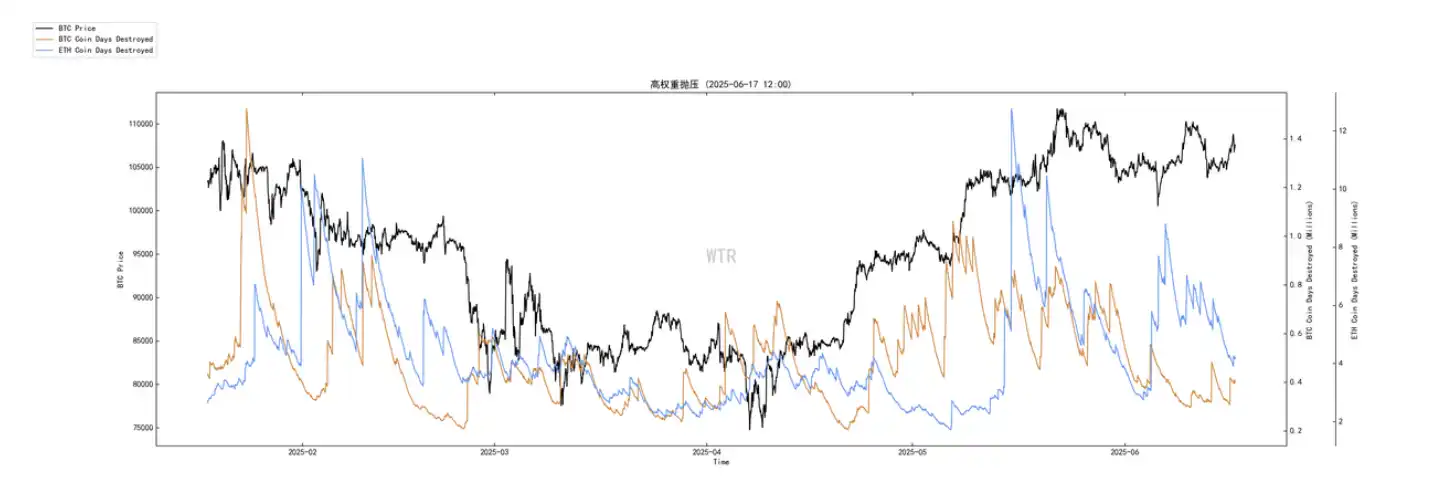
Currently, there is no high-weight selling pressure.
Purchasing power rating: Global purchasing power has decreased slightly, while stablecoin purchasing power remains stable compared to last week.
(The following image shows global purchasing power status)
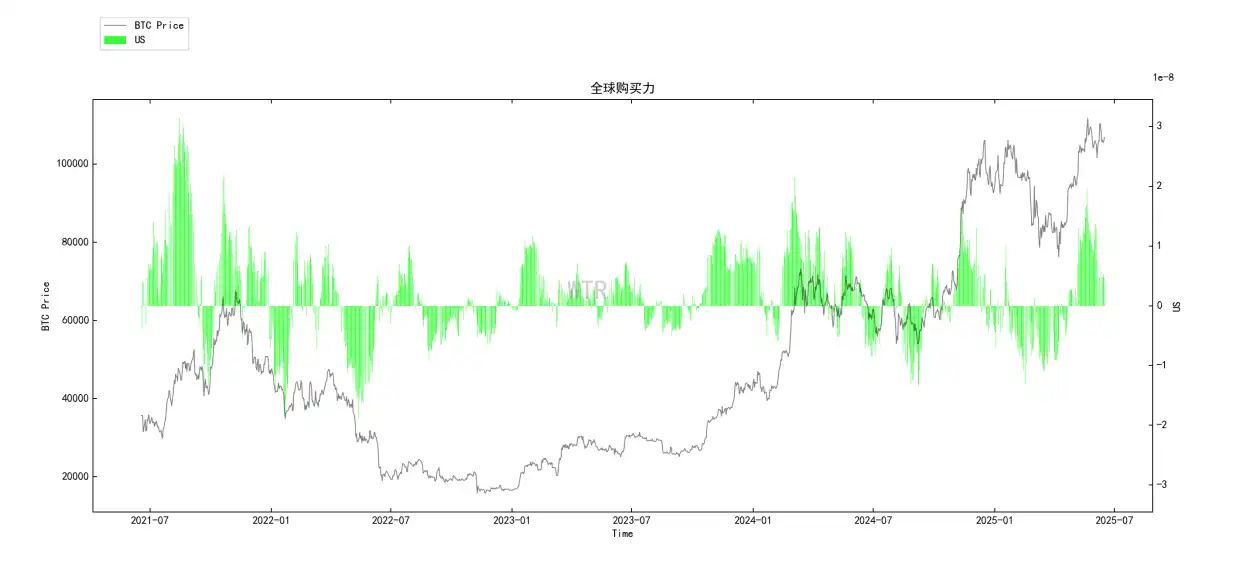
Global purchasing power has decreased slightly but remains positive.
(The following image shows the net position of the USDT trading platform)
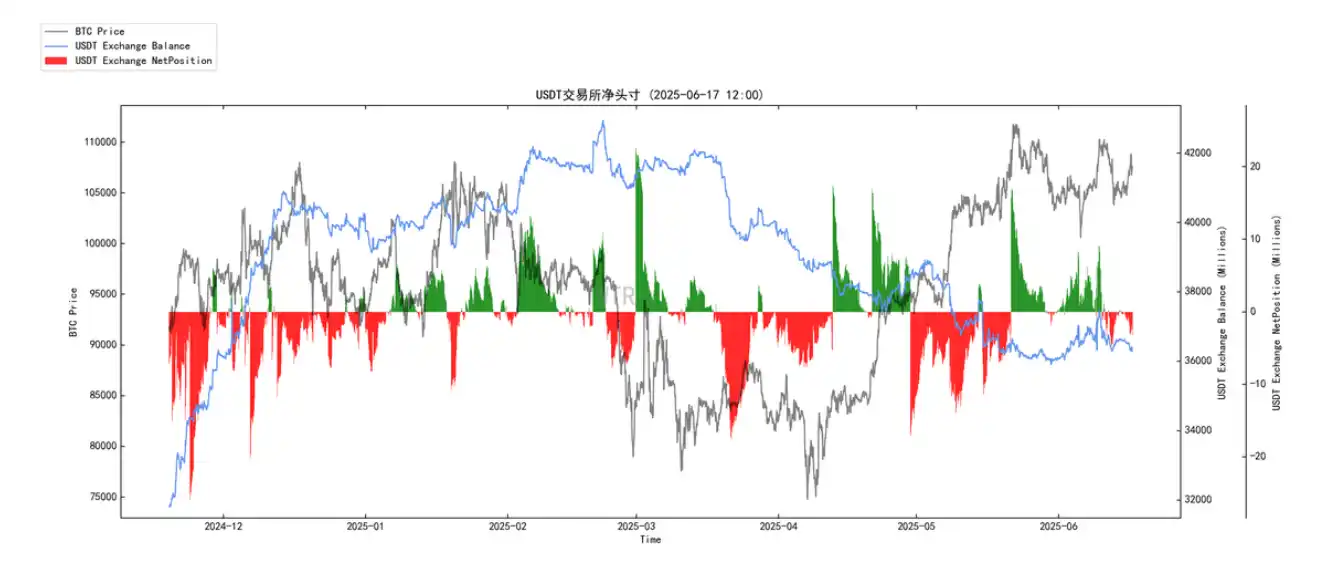
The purchasing power of stablecoins remains stable compared to last week.
This Week's Summary:
News Summary:
For the current market, the most direct observation is that it is in a state of holding its breath and waiting. Everyone's focus is on the Federal Reserve's meeting early Thursday morning, waiting for a signal regarding the future direction of interest rates. The short-term fluctuations in gold, oil, stocks, and even cryptocurrency assets seem to be bets or risk hedges in anticipation of this signal. This is a simple and clear fact, and it serves as a starting point for discussion.
Of course, an important question arises. If the decisive factor for the market is merely macro monetary policy, then why, under the relatively clear tightening expectations and geopolitical tensions in recent times, have digital assets represented by Bitcoin not experienced a catastrophic decline? The data we see, on the contrary, shows a resilience that is distinctly different from previous cycles. This indicates that the most direct answer may not be complete. There must be some force counteracting the macro pressure, suggesting that we need to shift our focus from the surface to explore the changes occurring within the market's internal structure.
To understand this new force, we can introduce a metaphor: imagine the entire digital asset market as a massive reservoir, with the water level representing asset prices. In the past, the water source for this reservoir primarily relied on natural rainfall—namely, scattered funds and market sentiment. When the weather is good (market sentiment is optimistic, macro is loose), rainfall is abundant, and the water level rises; when the weather is bad (market panic, macro tightening), rainfall decreases or even leads to drought, causing the water level to drop. Therefore, the water level of the reservoir is extremely sensitive to the "weather."
Now, however, a fundamental change has occurred. Next to the reservoir, a massive, sturdy, and continuously flowing water diversion channel has been constructed. This water diversion channel represents the spot ETF channels led by institutions like BlackRock. It is unaffected by short-term weather changes and steadily injects net water into the reservoir every day according to a predetermined engineering design. The "seven consecutive weeks of net inflows" and "year-to-date total inflow reaching new highs" mentioned in the news are direct evidence of this water diversion channel operating efficiently. At the same time, publicly listed companies converting part of their balance sheets into Bitcoin, or the continuous accumulation by large on-chain holders, can be seen as additional deep wells supplementing the water supply outside the water diversion channel. Now, looking at the water level of the reservoir, the external "weather" (the Federal Reserve's interest rate decisions, geopolitical conflicts) remains important, as it determines the "evaporation rate" of the reservoir.
A hawkish signal acts like a dry hot wind, accelerating evaporation and putting downward pressure on the water level. A dovish signal, on the other hand, is like a timely rainstorm, helping the water level rise more quickly. Of course, the decisive factor has changed. As long as the net inflow from the "water diversion channel" exceeds the "evaporation" caused by deteriorating "weather" in the long term, the long-term trend of the water level in this reservoir will inevitably be upward.
This is the source of market resilience: a continuous, structural, and non-emotional buying force (the water diversion channel) is offsetting and absorbing a fluctuating, cyclical, and emotional macro pressure (the weather). Therefore, we can return to the initial observation. People are closely watching the Federal Reserve, just as farmers care about weather forecasts, which is understandable because it directly affects short-term harvests. However, what truly changes the entire regional water ecosystem is not a single rainstorm, but the water diversion channel that has been built, fundamentally altering the structure of water supply.
From this, we can draw a conclusion: in the short term, the market is indeed acting based on the "face" of the Federal Reserve, but this is merely a surface phenomenon. The long-term value and stability of the market increasingly depend on its internal "structural water supply system"—that is, the institutionalized and compliant channels for capital inflow.
Therefore, in preparing for subsequent processes, the key lies in switching the analytical perspective: from an excessive focus on short-term, volatile "weather forecasts" to continuously measuring the flow and health of that "water diversion channel." Because as long as the flow of the water diversion channel does not stop, even if the water level in the reservoir temporarily recedes due to drought, it will ultimately fill up and overflow, flowing to higher places.
Short-term Outlook: Focus on Monetary Policy, Manage Volatility.
The core of this phase is the uncertainty of the external macro environment, which, like "weather," directly affects the market's short-term sentiment and price fluctuations.
Core Focus:
Federal Reserve Monetary Policy: Interest rate decisions, economic outlook summaries, and the tone of Chairman Powell's speeches are the absolute focus of the market. Any hawkish or dovish signals will be quickly amplified.
Key Economic Data: Inflation data such as CPI (Consumer Price Index) and PPI (Producer Price Index) will directly impact the market's expectations for the Federal Reserve's future actions.
Market Performance:
• High volatility, range consolidation. In the absence of clear macro tailwinds or headwinds, the market is likely to maintain a significant range of "tug-of-war," that is, a confrontation between structural buying and macro selling pressure.
Long-term Outlook: Measure "Water Flow," Grasp Trends
The core of this phase is the structural changes within the market, which, like the "water diversion channel," provide continuous and stable value support, determining the long-term trend of the market.
Core Focus:
• How structural capital inflows evolve and the evolution of regulatory frameworks.
• Clarification of regulatory policies in major markets such as the U.S. and Hong Kong is a systemic guarantee for attracting more mainstream capital into the market.
Performance:
• The value floor may rise: Although there will be volatility in the short term, in the long term, due to the presence of continuous net buying, the market's value center and price floor will steadily rise.
On-chain Long-term Insights:
The core narrative of the market is a profound and lasting transfer of its ownership structure.
It is transitioning from a speculation market dominated by short-term liquidity to a configuration market dominated by long-term value storage.
On-chain data comprehensively confirms this process;
The supply side is being locked and solidified on an unprecedented scale, while the demand side is seeing the emergence of structural new forces from the mainstream world.
• Market Tone:
The current market is in a "structural bull market" during a "consolidation digestion period." Its surface calm or volatility does not obscure the ongoing strengthening of the internal structure. This is a phase that requires patience, shifting the analytical focus from short-term price predictions to measuring long-term structural changes.
On-chain Mid-term Exploration:
- The decline in new liquidity has led the market to lean towards stock oscillation, with participants possibly engaging in a wait-and-see game.
- Whale liquidity supply remains strong, supporting BTC's high-level oscillation in a stock state.
- BTC is experiencing weak accumulation on trading platforms, with a small outflow currently.
- The supply of short-term participants is declining, with a significant stock structure.
- Global purchasing power is decreasing, and the market is gradually returning to rationality and calm.
- The chip structure indicates support at $102,000, with upward energy weakening above $110,500.
• Market Tone:
Stock game, high-level oscillation
The current market is primarily focused on stock games, likely waiting for a turning point amid high-level oscillation.
On-chain Short-term Observations:
The risk coefficient is in the red zone, indicating high derivative risk.
New active addresses are at a medium-low level.
Market sentiment state rating: Neutral.
The net position of BTC on trading platforms is in a continuous large outflow state, while ETH has a small outflow.
Global purchasing power has decreased slightly, while stablecoin purchasing power remains stable compared to last week.
The probability of not breaking below $95,000 to $100,000 in the short term is 80%;
• Market Tone:
In the short term, the overall market sentiment is relatively neutral and cautious, with no signs of frenzy or panic. Unless there are particularly unexpected news impacts, the expectations for this week remain consistent with last week, with the market being influenced by derivatives while leaning towards oscillation, and the probability of a direct large retracement or significant short squeeze is low.
Risk Reminder: The above is all market discussion and exploration, and does not constitute directional opinions for investment; please approach with caution and guard against market black swan risks.
This article is from a submission and does not represent the views of BlockBeats.
免责声明:本文章仅代表作者个人观点,不代表本平台的立场和观点。本文章仅供信息分享,不构成对任何人的任何投资建议。用户与作者之间的任何争议,与本平台无关。如网页中刊载的文章或图片涉及侵权,请提供相关的权利证明和身份证明发送邮件到support@aicoin.com,本平台相关工作人员将会进行核查。



